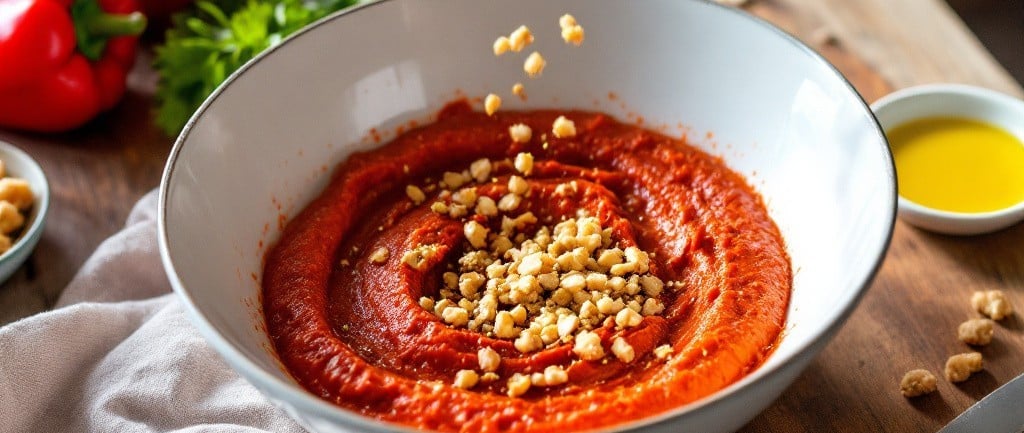Mahummara Dip
Muhammara is a rich and flavorful dip originating from the Middle East. Perfect for pairing with warm pita bread, fresh vegetables, or as a spread for sandwiches and grilled meats. Muhammara is a versatile dip that brings the authentic taste of the Mediterranean to your table.
EASY TO MAKEDIPVEGETARIAN
Lourdes Rodriguez
3/24/20252 min read


Origin or History of Muhammara
Muhammara is a rich and flavorful Middle Eastern dip that originated in Aleppo, Syria. The recipe for Muhammara dates back centuries, but it is difficult to pinpoint an exact age. It is believed to have been developed around the time of the Ottoman Empire, which spanned from the 14th to the early 20th century. The name "Muhammara" translates to "reddened" in Arabic, referring to its vibrant red color. Traditionally, it is made from roasted red peppers, walnuts, breadcrumbs, olive oil, lemon juice, and pomegranate molasses, creating a perfect balance of smoky, tangy, sweet, and nutty flavors. Over time, this dip has gained popularity across the Mediterranean and beyond.
Health Benefits of Muhammara
Muhammara is packed with health benefits due to its nutrient-dense ingredients:
Red Peppers: High in vitamin C and antioxidants, supporting immune function and skin health.
Walnuts: Rich in omega-3 fatty acids, which promote brain and heart health.
Olive Oil: Provides healthy monounsaturated fats, beneficial for cardiovascular health.
Pomegranate Molasses: Contains polyphenols that help fight inflammation and support digestion.
Tips for Making Muhammara
Roast the Peppers Well: For an authentic smoky flavor, roast red peppers over an open flame or in the oven until charred.
Use High-Quality Olive Oil: This enhances the creaminess and richness of the dip.
Adjust Consistency: If the dip is too thick, add a splash of water or more olive oil to reach your desired texture.
Toast the Walnuts: Lightly toasting them enhances their nutty flavor and adds depth to the dip.
Muhammara Recipe
Ingredients:
2 large red bell peppers, roasted and peeled
1/2 cup walnuts, toasted
1/4 cup breadcrumbs
2 tablespoons pomegranate molasses
2 tablespoons extra virgin olive oil
1 teaspoon ground cumin
1 teaspoon smoked paprika
1 clove garlic, minced
Juice of 1/2 lemon
Salt and pepper to taste
Instructions:
Roast the red bell peppers over an open flame or in the oven at 400°F (200°C) until the skin is charred. Let them cool, then peel and remove the seeds.
In a food processor, combine the roasted peppers, walnuts, breadcrumbs, pomegranate molasses, olive oil, cumin, smoked paprika, garlic, lemon juice, salt, and pepper.
Blend until smooth. Adjust seasoning as needed.
Transfer to a serving bowl and drizzle with extra olive oil. Serve with pita bread, crackers, or vegetables.
Notes:
Use a blender if you do not have a food processor to puree the ingredients.
Store Muhammara in an airtight container in the refrigerator for up to 5 days.
For longer storage, freeze in small portions for up to 3 months and thaw in the fridge before serving.
Do not consume if it smells sour or has developed mold.
Suggestions for Healthier Ingredient Swaps
Replace breadcrumbs with ground flaxseeds or almond flour for a gluten-free option.
Substitute walnuts with sunflower seeds if you have a nut allergy.
Use balsamic reduction instead of pomegranate molasses if unavailable.
Main & Side Dishes to Pair with Muhammara
Main Dishes: Grilled chicken, lamb kebabs, or roasted vegetables.
Side Dishes: Pita bread, pasta or fresh vegetable sticks.
Did you know? Muhammara’s primary ingredient is red bell pepper, belong to the same botanical family as chili peppers but contain little to no capsaicin, making them sweet rather than spicy.
Some Individuals May Need to Limit or Avoid Muhammara
Those with Nut Allergies: Walnuts can trigger severe allergic reactions. Swap for sunflower seeds or roasted chickpeas.
People with Acid Reflux: Pomegranate molasses and lemon juice may be too acidic; consider using a small amount of honey instead.
Individuals with Gluten Sensitivity: Traditional recipes contain breadcrumbs. Opt for gluten-free alternatives like almond flour.
Important: If you have any doubts about incorporating this food into your diet, it is always a good idea to consult with your dietician or doctor.
Plenitaste
Inspiring healthy, global recipes for everyone.
contact me:
Recipe
plenitaste@gmail.com
© 2025. All rights reserved.
